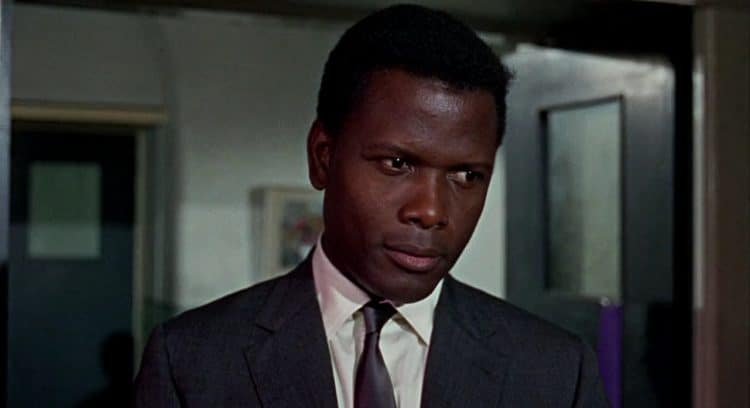
Some actors are generational talents. Sidney Poitier defined a generation. His many accolades include the Screen Actors Guild Life Achievement Award, an Honorary Knight Commander of the Order of the British Empire, the Kennedy Center Honor, and the Presidential Medal of Freedom. The actor also turned 94 in February of 2021. That same month, Chadwick Boseman won the Golden Globe for Best Performance by an Actor in a Motion Picture (Drama). In the seventy-eight year history of the Golden Globes, he was only the fourth black man to ever win the award. Sidney Poitier was the first. Due to his immaculate good looks, immense talent and impeccable charm, Poitier delineated a new conception for the Negro actor. He also broke barriers. In 1964, he became the first black man to win the Academy Award for Best Actor. However, the zenith of his career came three years later.1967 saw Sidney star in three very significant films playing three very distinct roles in a very turbulent time in America. It may be the most momentous single year for any actor in the history of cinema.
“To Sir, with Love” was released in June of 1967 and marked the first Poitier film of the year. The movie stars Sidney as Mark Thackeray, a British Guianese immigrant with a degree in engineering who is forced to take a job at a tough high school in London’s East End. At first, the unruly class of mostly white students refuses their new teacher’s efforts at every turn. When Thackeray is unfazed by the rambunctious pupils, the class comes to respect him. Then they grow to admire him. This picture provides a good representation of the aspiration to overcome differences to find common ground. The differences between the students and teacher include generational, social, racial and cultural mirroring a microcosm of American society. By the end of the film, it is made clear that a little understanding and encouragement go a long way. “To Sir, with Love” was the seventh highest grossing film of the year and currently holds a Rotten Tomatoes rating of 89%.
In August, Sidney’s second film of the year was released. Directed by Norman Jewison, “In the Heat of the Night” is an intense thriller set in modern era Mississippi. The story revolves around a Philadelphia homicide expert (Poitier) who helps the small town southern Police Chief (Rod Steiger) investigate the murder of a wealthy white businessman. The racial elements in this movie jolted America. It characterized a time and place where racism was not only overt, it was customary. But in the end, the main characters are able to overcome their prejudices for the greater good. The film is an undisputed classic and Sidney plays one of the most iconic roles of all time in it. He is Inspector Virgil Tibbs. As in, “They call me Mister Tibbs!” The character is significant because he refused to be intimidated by the racist collective. Poitier was nominated for a Golden Globe for his role while the movie won five Academy Awards including Best Picture. In 2002, the film was selected for inclusion in the United States National Film Registry citing its status as being “culturally, historically, or aesthetically significant”. “In the Heat of the Night” carries a Rotten Tomatoes rating of 95%.
“Guess Who’s Coming to Dinner” was the final Sidney Poitier film of 1967. It tells the story of a privileged, twenty-three year old white woman (Katharine Houghton) who falls in love with a thirty-seven year old doctor played by Sidney. The couple intends to get married but Poitier’s character refuses unless they have the unadulterated and unconditional blessing from the woman’s parents. This movie deals with the theme of race in a much more clever way than the previous two Poitier films. The woman’s parents are very liberal. They never considered themselves racist; until the prospect of their daughter marrying a black man presented itself. Played brilliantly by Spencer Tracy and Katharine Hepburn, the woman’s parents are forced to confront their sincere feelings of equality and true definition of bigotry. In America at the time, the issue of interracial marriage was a divisive topic to put it mildly. Six months before the release of the film, interracial marriage was still illegal in 17 states. Despite the inherent controversy, “Guess Who’s Coming to Dinner” went on to be an incredible success. It was the third highest grossing film of the year and was nominated for ten Academy Awards.
Sidney Poitier was overwhelmingly the most successful actor of 1967. He starred in three of the top eleven grossing movies of the year which accounted for seventeen Academy Award nominations. But his commercial accomplishments were not why it was such a landmark year for the actor. In a time of intense racial division in America, he helped usher in a new era of diversity. His three performances not only disproved racial stereotypes, they proved that black actors were capable of carrying a film primarily intended for white audiences. At the end of 1967, Sidney Poitier was referred to as “one of the best actors in the world” instead of “one of the best Negro actors in the world”. That was the true accomplishment.
 Follow Us
Follow Us





